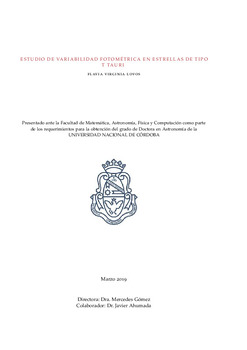| dc.contributor | Ahumada, Javier Alejandro | |
| dc.contributor.advisor | Gómez, Mercedes Nieves | |
| dc.contributor.author | Lovos, Flavia Virginia | |
| dc.date.accessioned | 2019-12-05T18:23:31Z | |
| dc.date.available | 2019-12-05T18:23:31Z | |
| dc.date.issued | 2019-03 | |
| dc.identifier.uri | http://hdl.handle.net/11086/14315 | |
| dc.description | Tesis (Doctor en Astronomía)--Universidad Nacional de Córdoba, Facultad de Matemática, Astronomía, Física y Computación, 2019. | es |
| dc.description.abstract | Las estrellas jóvenes de tipo T Tauri tienen la edad adecuada para el inicio del proceso de formación planetaria de acuerdo a los modelos más aceptados en la actualidad. Sin embargo éstas presentan algunos desafíos para la técnica clásica de detección de planetas extrasolares mediante tránsitos planetarios. Principalmente las T Tauri manifiestan diversas formas de variabilidad que, mayormente, se evidencian en sus curvas de luz. En este trabajo se presenta un análisis y caracterización de la variabilidad fotométrica de 52 estrellas T Tauri australes, a partir de datos propios obtenidos desde el CASLEO y de la EABA, como primer paso para comprender cómo esta variabilidad puede influir en la detectabilidad de potenciales embriones planetarios transitantes. Entre los tipos de variabilidad observados, el más frecuente se debe a la presencia de manchas sobre la superficie estelar, así como otros relacionados con procesos de acreción y/o obscurecimiento por polvo en discos circunestelares. | es |
| dc.description.abstract | Young pre-main sequence stars of T Tauri type have appropriate ages for the beginning of the planetary formation process according to the currently most accepted models. However, T Tauri stars offer some challenges for the classical techniques of extrasolar planets detection by means of planetary transits. Principally, T Tauri stars have different types of variability that are mostly evident in their light curves. In this work is presented an analysis and characterization of the photometric variability of 52 southern T Tauri stars, from data obtained from the CASLEO and the EABA observatories, as a first step to learn how such variability may affect the detectability of transiting planetary embryos. Among the types of variabilities, the most frequent are due to the presence of spots on the stellar surfaces, as well as others related to processes of accretion and/or darkening by dust in the circumstellar disks. | en |
| dc.language.iso | spa | es |
| dc.rights | Attribution-NonCommercial-NoDerivatives 4.0 Internacional | * |
| dc.rights.uri | http://creativecommons.org/licenses/by-nc-nd/4.0/ | * |
| dc.subject | Estrellas | es |
| dc.subject | Planetas extrasolares | es |
| dc.subject | Estrellas T Tauri | es |
| dc.subject | Estrellas Herbig Ae/Be | es |
| dc.subject | Observation and data reduction techniques | en |
| dc.subject | Photography and photometry | en |
| dc.subject | Image processing | en |
| dc.subject | Stellar characteristics and properties | en |
| dc.subject | Star formation | en |
| dc.subject | Extrasolar planetary systems | en |
| dc.subject | Photometric and spectroscopic detection | en |
| dc.subject | Stellar activity | en |
| dc.subject | Time series analysis, time variability | en |
| dc.title | Estudio de variabilidad fotométrica en estrellas de tipo T Tauri | es |
| dc.type | doctoralThesis | es |
| dc.description.version | info:eu-repo/semantics/publishedVersion | |
| dc.description.fil | Lovos, Flavia Virginia. Universidad Nacional de Córdoba. Facultad de Matemática, Astronomía, Física y Computación; Argentina. | es |





